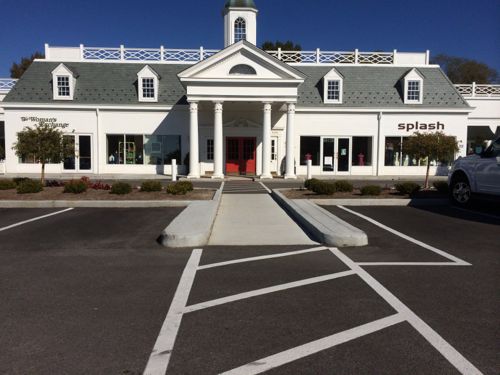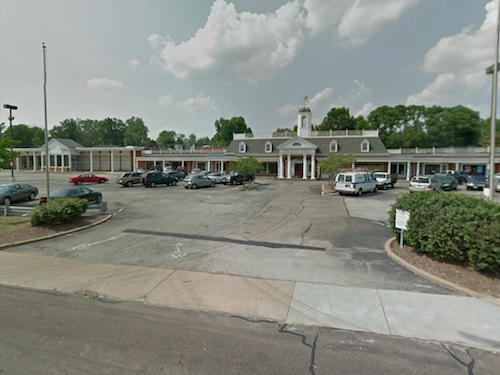Automobile Driveway Replaced With Pedestrian Access Route
Every so often I get back to a once-familiar place and I’m pleasantly surprised by positive changes. Recently I drove through the strip mall on Ladue Road that formerly contained a Wild Oats store, in a space previously occupied by a Schnucks. Wild Oats was bought out by Whole Foods in 2007, leaving the dated center largely vacant. The strip center underwent renovations in 2012.

A decade ago I visited the Wild Oats every morning before work, but I’d forgotten the exact layout of the parking lot. So I turned to Google Maps and it still showed the old pattern, with a wide auto driveway where the dedicated pedestrian path is now.

Most of the center, including the pedestrian access, is located in Ladue, while the east end is located in Clayton. St. Louis County records indicate this strip mall was built in 1960, a time when wide auto driveways were valued but more and more developers & retailers know walkability and a more pleasant arrival sells, especially to those with disposable incomes.
Kudos to those responsible.
— Steve Patterson
While I agree that this is a big improvement, I think that you’re taking it a bit too far when you say that “more and more developers & retailers know walkability and a more
pleasant arrival sells, especially to those with disposable incomes.” Many people with large disposable incomes are only interested in themselves and how close they can park their Mercedes / Audi / Porsche / Lexus to the front door and to make sure that it doesn’t get scratched. I’m guessing (and you can prove me wrong) that the combination of doing ADA right and Ladue’s aesthetic expectations played a much bigger role in these changes, along with a desire to increase the total number of spaces available*, than any internal desire by the developer to make this site more walkable, especially to those who don’t drive. If that were truly the case, we’d be seeing the same thing out at the two new outlet malls in Chesterfield!
*The site previously had four vehicular access points. Eliminating one (or two) would (and probably did) both improve internal traffic flow (fewer conflict points) and provide more real estate for static parking. I did that once on a project, where by reorienting the parking from N-S to E-W we were able to add 20-some spaces.
I’ve already visited both new outlet malls, one has a very nice access route from the exterior of the site. Deny the importance of walkability all you want, but it is becoming increasingly important. This isn’t to say it gets highly used, but the appearance matters.
I agree that walkability is important in an urban context. Creating the appearance of walkability in a suburban or rural context does little to get people to actually WALK! It may matter to you, but to me it’s more of a caricature and a superfluous expense. To really get people to walk, especially in a retail context, you need density, and suburban and rural areas, by definition, are not dense!
This location presents an interesting dichotomy – to the east is Clayton, which borders on being urban, and to the west is Ladue, which borders on being rural. I’m going to continue to argue that the real reason that this was done, here, was primarily to get more needed parking spaces on a confined site than it was to enhance any sort of “pedestrian experience”.
I agree more parking was the goal, but I’ve seen other retail cases where the drive is simply eliminated. The new Family Dollar at Grand @ Magnolia, for example. My point is when designing for the upper class the overall experience/appearance matters. Including nice walkability is fast becoming a prerequisite.
the drive at Grand and Magnolia on the Family Dollar lot was not eliminated to encourage pedestrian traffic. It was to protect first and foremost to prevent car accidents and to protect the pedestrians both blind and elderly that cross there was just an added benefit. Too many car accidents and close accidents have happened because the drive did not align with Magnolia. The Manor had been trying for years to get this exit closed because too many times, their building had been hit, the exit was too steep and slippery…especially when ice was around, the wall was repeatedly damaged by cars hitting it, etc. Pedestrians had very little to do with this decision.
Thanks, you made my point, Pedestrians aren’t considered in less affluent areas. However, the driveway next to the adjacent building remains open. The next driveway to the north was eliminated – but they didn’t add a pedestrian route required by the ADA.
This post is great. I have sat in meetings with numerous architects, and pedestrian walkways are more and more in “vogue” these days. While they are not a focus on developers, they do tend to be part of any site plan I have seen (since my debacle with County Market in “downtown” Springfield). A new outlet mall is being built here and the site include four different ways into the site by foot and/or bike. They are at least including them now to “say” they are “pedestrian-friendly,” even if the site is generally designed for the automobile. For me, simply including pedestrians is a great start!